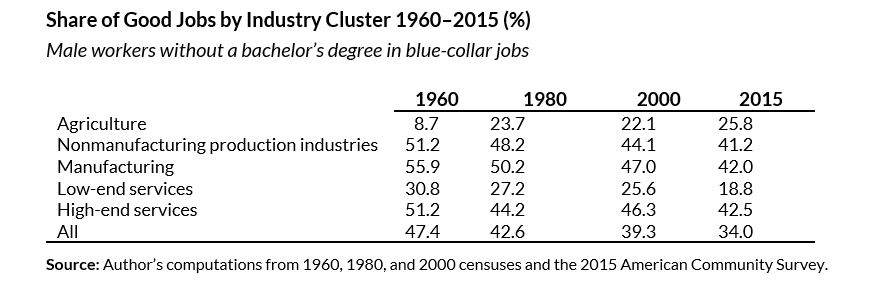
<p>Leslie Dube, a production technician at Cuddledown, a bedding manufacturer in Yarmouth, ME, wheels an empty bin toward her workstation . Photo by Ben McCanna/Portland Press Herald via Getty Images.</p>
Bringing manufacturing jobs back to the US was a key element of President Trump’s campaign, as he tapped into economic anxiety in the Rust Belt states. “One by one, the factories shuttered and left our shores, with not even a thought about the millions upon millions of American workers left behind,” Trump said in his inaugural address.
Senator Bernie Sanders also emphasized manufacturing jobs during his campaign, aligning with Trump on his opposition to foreign trade deals and lamenting the trade deficit.
This focus on manufacturing is rooted in the sector’s history, as it was once considered the most important source of stable employment for working-class families. People often tie the explosive growth of the middle class after World War II to the relatively high wages of male manufacturing workers.
Manufacturing employment fell from 32 percent of the US workforce in 1960 to 11 percent in 2015, and politicians point to that decline as an indicator of increasing economic hardship among men without a bachelor’s degree. Many pundits blame foreign trade and the trade deficit for the steep drop in manufacturing employment.
But research shows that isn’t the case. Our recent briefs offer evidence on employment and productivity trends in the manufacturing sector, trade’s impact on manufacturing jobs, and the employment trajectories of men without a four-year degree. These findings also coincide with a new International Monetary Fund study that concluded declining manufacturing employment doesn’t lead to higher income inequality or slower economic growth.
Our research offers evidence to dispel the following myths about manufacturing jobs.
Myth #1: The trade deficit caused the manufacturing employment downturn.
The trade deficit accounted for only about 10 percent of the decline in manufacturing employment, while the remaining 90 percent resulted from increased productivity and technological advances, per our research. Eliminating the trade deficit could add about 3 million manufacturing jobs in the US, but it would not restore the industry to 32 percent of the total workforce.

Although both the share and the number of workers employed in US manufacturing declined between 1960 and 2015, manufacturing’s output increased nearly 500 percent.
Myth #2: The manufacturing employment decline was the main factor in the lower share of “good jobs” available to men without a bachelor’s degree.
Across all industries, the share of “good jobs” (or jobs that allow workers to support their family at or above the 40th percentile of the population) for men without a bachelor’s degree fell from 47 percent in 1960 to 34 percent in 2015. The overall manufacturing employment decline contributed to some of that dip, but even within the manufacturing sector, the share of good jobs fell from 56 percent in 1960 to 42 percent in 2015. Further, the share of good jobs for men with a bachelor’s degree fell in all major industry groups except for agriculture.

By our calculations, three-quarters of the decline in the share of good jobs available for men without a bachelor’s degree is because of lower relative pay within industries, and only one-quarter is because of the movement from being employed in manufacturing to being employed in low-paying service and retail jobs.
Myth #3: The loss of blue-collar jobs in manufacturing has forced men without a bachelor’s degree into low-paying service jobs.
In 1960, nearly 57 percent of men without a bachelor’s degree worked in blue-collar occupations (or jobs that involve manual labor with machines, vehicles, and moving materials). By 2015, that share dropped to 43 percent. But blue-collar jobs were and continue to be available in all industries, not just manufacturing. Although the share of men without a bachelor’s degree in blue-collar jobs employed in manufacturing declined 22 percentage points between 1960 and 2015, the combined share working in high-end services and nonmanufacturing production industries rose 14 percentage points.

This shift from blue-collar jobs in manufacturing to blue-collar jobs in high-end service and nonmanufacturing production industries are largely lateral moves in terms of pay for these men. Only about one-third of the shift out of manufacturing for these men can be accounted for by a rise in low-end service-sector industries.
Policy approaches to help workers displaced by manufacturing’s decline
Because manufacturing is unlikely to generate enough new jobs to return the sector to its past prominence, policymakers and stakeholders should consider other strategies to help men without a four-year degree:
- Fund training and apprenticeship programs for industries that now provide most good jobs for men without a bachelor’s degree. The nonmanufacturing production industries of construction, transportation, utilities, warehousing, and wholesaling employ twice as many men without a bachelor’s degree in blue-collar jobs than the manufacturing industry.
- Form collaborations between community colleges and local employers to provide more targeted apprenticeships and vocational and technical training programs for workers who are unlikely to earn a four-year degree.
- Create higher-paying jobs in low-end services and retail industries. Other countries with effective high minimum wages have higher salaries for low-end service workers.
Let’s build a future where everyone, everywhere has the opportunity and power to thrive
Urban is more determined than ever to partner with changemakers to unlock opportunities that give people across the country a fair shot at reaching their fullest potential. Invest in Urban to power this type of work.